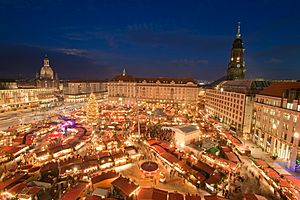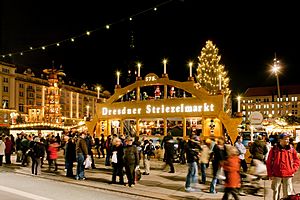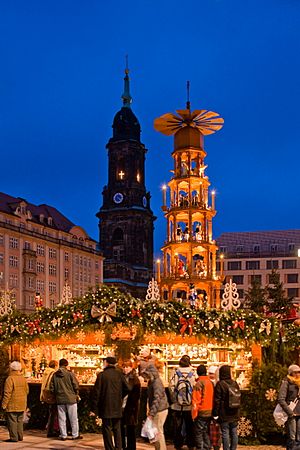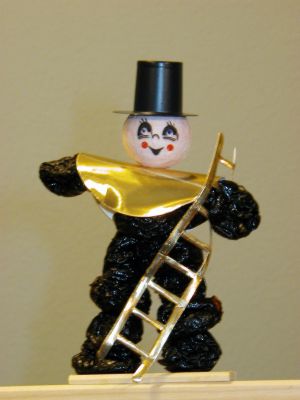Striezelmarkt facts for kids
The Striezelmarkt in Dresden, Germany, is known as the first real Christmas market in the world. It started as a one-day market way back in 1434. In 2019, it celebrated its 585th birthday! Today, this amazing market has 240 stands and welcomes about 3 million visitors from all over the world each year. The market stays open throughout the Advent season, right up until Christmas Eve.
Contents
History of the Striezelmarkt
The Striezelmarkt was first mentioned in official papers in 1434. It was started by Friedrich II, who was a ruler of Saxony. The market was held on the Altmarkt square in Dresden.
At first, it was just a one-day market. Its main purpose was to let the people of Dresden buy meat for their Christmas meals. This was important because during the Advent period, people traditionally fasted, meaning they didn't eat meat.
Over hundreds of years, the Striezelmarkt grew a lot. In the 21st century, it became a huge event with 240 different stands. It now covers a big part of Dresden's city center. The market stays open for the entire Advent season, ending on Christmas Eve. Today, about 3 million people visit the Striezelmarkt every year.
Where the Name "Striezelmarkt" Comes From
The name Striezelmarkt comes from an old word, Strüzel or Stroczel. This was the name of a special cake sold at the market. Today, this cake is famous around the world as Stollen or Christstollen.
Stollen is a light and airy fruitcake that doesn't have too much sugar. The real Dresden Stollen is made only in Dresden. It has a special seal that shows Augustus II, who was a powerful ruler and King of Poland. The shape of the cake looks like the entrance to a mine tunnel. This reminds people of the area's history of silver and tin mining.
What You Can See at the Striezelmarkt Today
The Dresden Striezelmarkt has many famous attractions. One is the world's largest usable Christmas arch. It is about 13.5 meters (44 feet) wide and more than 5 meters (16 feet) tall! Another amazing sight is the 14-meter (46-foot) tall Erzgebirge Christmas pyramid.
There's also a special children's adventure world at the market. Kids can visit the prune chimney sweep’s cottage or the bakery. Here, they can knead dough and do fun crafts. There's also a puppet theater, a merry-go-round, and a children's train.
Every day, there are shows and performances on the Striezelmarkt stage. On Advent weekends, special events take place. These include the Dresden Stollen Festival and the Pyramid and Christmas Arch Festival.
In the middle of the Striezelmarkt, there's a 20-meter (66-foot) tall spruce tree. It comes from the nearby Tharandt woods and is decorated with many lights. At the back of the market, you can find a painted wooden fairy-tale castle. This castle works like a giant Advent calendar. Each day, entertainers open a door and put on a puppet show for the children. On Fridays, Father Christmas himself comes to visit!
Special Wooden Ornaments
Many stands at the Striezelmarkt sell beautiful carved wooden ornaments. These come in all shapes and sizes. This tradition started a long time ago, linked to the area's mining history.
Dresden is close to the Erzgebirge, also known as the Ore Mountains. Silver and tin were found here around 1168. Many miners came to work, but later they lost their jobs. To earn money, the miners started carving wood. They often included mining symbols and religious designs in their carvings. You can still see these symbols in the Christmas ornaments sold at the Striezelmarkt today.
Candle Pyramids
Christmas pyramids are popular decorations in Germany. Many families bring them out every year to light up their homes at Christmas. These pyramids have two to five round wooden levels that get smaller towards the top. They are built around a central rod. The levels spin around because of the heat from candles rising up to a fan at the top. Each level has figures related to Christmas.
The tallest pyramid in the world stands at the Striezelmarkt. It is a huge 14 meters (46 feet) tall! Originally, pyramids were much simpler, just a frame to hang fir branches on. The modern candle pyramid was developed in the early 1800s.
Schwibbogen (Candle Arches)
The word Schwibbogen means an arch that "hangs" between two walls. This special candle-holder is shaped like an arch. It represents the arched entrance to a mine, lit up with guiding lights. This is another link to the area's mining past. Today, the "candles" are often electric lights.
The wooden scenes cut into the center of the arch are not just about mining. During Advent nights, almost every window in Dresden is lit up with these beautiful ornaments. People traditionally buy them at the Striezelmarkt.
Räuchermann (Smoking Man)
Another popular Christmas ornament in Germany is the smoking man. This figure is hollow inside, with a hole leading to its mouth. An incense candle is placed inside, making it look like the figure is smoking as the candle burns.
You can find many different kinds of smoking men. There are old ladies in rocking chairs, Father Christmases, and figures showing almost every job. Smoking men first appeared at the Striezelmarkt in the 1800s.
Nutcrackers
The type of nutcracker often sold at the Striezelmarkt is carved and painted like a soldier with a red coat. These nutcrackers became famous worldwide thanks to Tchaikovsky's Nutcracker Suite ballet.
Wilhelm Friedrich Füchtner, a wood turner from the Ore Mountains, was one of the first to carve nutcrackers in this soldier shape. People say he was inspired by the nutcracker in the storybook that Tchaikovsky used for his ballet.
Food and Drinks at the Striezelmarkt
Besides the famous Stollen, other special foods and drinks come from Dresden. Many of these were first sold at the Striezelmarkt.
Pflaumentoffel (Prune Figures)
Pflaumentoffel are small figures made from prunes. Even though they are made of fruit, they are mostly decorations. You can eat them after Christmas, though! Pflaumentoffel means plum devil. But they are not devils; they are meant to look like chimney sweeps. They are dressed all in black (the prunes) with a top hat and a brush.
Until the 1900s, children would carry trays of Pflaumentoffel at the Striezelmarkt. They sold them to earn some Christmas money. A famous artist, Ludwig Richter, even drew these "Striezelkinder" (Striezel children) in 1853. However, in 1910, selling by children was no longer allowed at the Striezelmarkt.
Pulsnitzer Pfefferkuchen (Pulsnitz Gingerbread)
The Christmas market in Nuremberg is very famous for its gingerbread, called Lebkuchen. But the Striezelmarkt's gingerbread has a long history too. Pfefferkuchen literally means "pepper cake." The word "pepper" was used to mean any new spice from other countries.
The gingerbread sold at the Striezelmarkt comes from Pulsnitz, a town about 50 km (31 miles) from Dresden. It was first mentioned as a special food from Pulsnitz in 1558. Pfefferkuchen are usually filled with marmalade or jam and covered with chocolate. Unlike gingerbread from other countries, the dough usually doesn't have any fat or even ginger. Instead, it uses spices like nutmeg, cinnamon, ground cloves, and allspice. These are added after the dough has been left to mature for up to six months!
In 1780, eight master bakers from Pulsnitz came to the Striezelmarkt to sell their gingerbread themselves. Today, there are many more Pfefferkuchen stands, but the gingerbread is usually sold by hired staff.
Glühwein (Mulled Wine)
A very popular tradition on a cold December night in Dresden is drinking steaming mugs of mulled wine at the Striezelmarkt. This hot red wine is spiced with cloves and cinnamon. It is served in special mugs that are often decorated for the market.
See also
 In Spanish: Striezelmarkt para niños
In Spanish: Striezelmarkt para niños





